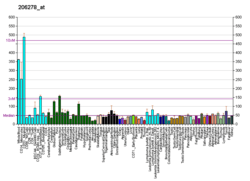Platelet-activating factor receptor
The platelet-activating factor receptor is a G-protein coupled receptor which binds platelet-activating factor.[5][6]
The PAF receptor shows structural characteristics of the rhodopsin (MIM 180380) gene family and binds platelet-activating factor (PAF). PAF is a phospholipid (1-0-alkyl-2-acetyl-sn-glycero-3-phosphorylcholine) that has been implicated as a mediator in diverse pathologic processes, such as allergy, asthma, septic shock, arterial thrombosis, and inflammatory processes.[supplied by OMIM][7] Its pathogenetic role in chronic kidney failure has also been reported recently.[8]
Ligands
Agonists
- Platelet activating factor
Antagonists
- Israpafant (Y-24180)
- WEB 2086
gollark: We use(d) it for advertising.
gollark: The heavserver banner.
gollark: derek1, that is.
gollark: Also the various ubqorals and possibly derek.
gollark: I'm not entirely sure why as many of them have never spoken and indeed are somehow missing from the search history.
References
- GRCh38: Ensembl release 89: ENSG00000169403 - Ensembl, May 2017
- GRCm38: Ensembl release 89: ENSMUSG00000056529 - Ensembl, May 2017
- "Human PubMed Reference:". National Center for Biotechnology Information, U.S. National Library of Medicine.
- "Mouse PubMed Reference:". National Center for Biotechnology Information, U.S. National Library of Medicine.
- Seyfried CE, Schweickart VL, Godiska R, Gray PW (1992). "The human platelet-activating factor receptor gene (PTAFR) contains no introns and maps to chromosome 1". Genomics. 13 (3): 832–4. doi:10.1016/0888-7543(92)90162-L. PMID 1322356.
- Ishii S, Nagase T, Shimizu T (2002). "Platelet-activating factor receptor". Prostaglandins Other Lipid Mediat. 68-69: 599–609. doi:10.1016/S0090-6980(02)00058-8. PMID 12432946.
- "Entrez Gene: PTAFR platelet-activating factor receptor".
- Correa-Costa M (Apr 2014). "Activation of platelet-activating factor receptor exacerbates renal inflammation and promotes fibrosis". Lab. Invest. 94 (4): 455–466. doi:10.1038/labinvest.2013.155. PMID 24492283.
Further reading
- Shukla SD (1992). "Platelet-activating factor receptor and signal transduction mechanisms". FASEB J. 6 (6): 2296–301. doi:10.1096/fasebj.6.6.1312046. PMID 1312046.
- Sugimoto T, Tsuchimochi H, McGregor CG, et al. (1993). "Molecular cloning and characterization of the platelet-activating factor receptor gene expressed in the human heart". Biochem. Biophys. Res. Commun. 189 (2): 617–24. doi:10.1016/0006-291X(92)92245-S. PMID 1281995.
- Seyfried CE, Schweickart VL, Godiska R, Gray PW (1992). "The human platelet-activating factor receptor gene (PTAFR) contains no introns and maps to chromosome 1". Genomics. 13 (3): 832–4. doi:10.1016/0888-7543(92)90162-L. PMID 1322356.
- Kunz D, Gerard NP, Gerard C (1992). "The human leukocyte platelet-activating factor receptor. cDNA cloning, cell surface expression, and construction of a novel epitope-bearing analog". J. Biol. Chem. 267 (13): 9101–6. PMID 1374385.
- Ye RD, Prossnitz ER, Zou AH, Cochrane CG (1991). "Characterization of a human cDNA that encodes a functional receptor for platelet activating factor". Biochem. Biophys. Res. Commun. 180 (1): 105–11. doi:10.1016/S0006-291X(05)81261-6. PMID 1656963.
- Nakamura M, Honda Z, Izumi T, et al. (1991). "Molecular cloning and expression of platelet-activating factor receptor from human leukocytes". J. Biol. Chem. 266 (30): 20400–5. PMID 1657923.
- Haslam RJ, Williams KA, Davidson MM (1986). Receptor-effector coupling in platelets: roles of guanine nucleotides. Adv. Exp. Med. Biol. Advances in Experimental Medicine and Biology. 192. pp. 265–80. doi:10.1007/978-1-4615-9442-0_19. ISBN 978-1-4615-9444-4. PMID 3010668.
- Valone FH (1984). "Isolation of a platelet membrane protein which binds the platelet-activating factor 1-0-hexadecyl-2-acetyl-SN-glycero-3-phosphorylcholine". Immunology. 52 (1): 169–74. PMC 1454573. PMID 6325330.
- Cundell DR, Gerard NP, Gerard C, et al. (1995). "Streptococcus pneumoniae anchor to activated human cells by the receptor for platelet-activating factor". Nature. 377 (6548): 435–8. doi:10.1038/377435a0. PMID 7566121.
- Izumi T, Kishimoto S, Takano T, et al. (1995). "Expression of human platelet-activating factor receptor gene in EoL-1 cells following butyrate-induced differentiation". Biochem. J. 305. ( Pt 3) (3): 829–35. doi:10.1042/bj3050829. PMC 1136334. PMID 7848283.
- Bito H, Honda Z, Nakamura M, Shimizu T (1994). "Cloning, expression and tissue distribution of rat platelet-activating-factor-receptor cDNA". Eur. J. Biochem. 221 (1): 211–8. doi:10.1111/j.1432-1033.1994.tb18731.x. PMID 8168510.
- Chase PB, Halonen M, Regan JW (1993). "Cloning of a human platelet-activating factor receptor gene: evidence for an intron in the 5'-untranslated region". Am. J. Respir. Cell Mol. Biol. 8 (3): 240–4. doi:10.1165/ajrcmb/8.3.240. PMID 8383507.
- Mutoh H, Bito H, Minami M, et al. (1993). "Two different promoters direct expression of two distinct forms of mRNAs of human platelet-activating factor receptor". FEBS Lett. 322 (2): 129–34. doi:10.1016/0014-5793(93)81552-B. PMID 8387031.
- Nakamura M, Honda Z, Matsumoto T, et al. (1993). "Isolation and properties of platelet-activating factor receptor cDNAs". Journal of Lipid Mediators. 6 (1–3): 163–8. PMID 8395240.
- Kishimoto S, Shimadzu W, Izumi T, et al. (1996). "Regulation by IL-5 of expression of functional platelet-activating factor receptors on human eosinophils". J. Immunol. 157 (9): 4126–32. PMID 8892648.
- Chase PB, Yang JM, Thompson FH, et al. (1997). "Regional mapping of the human platelet-activating factor receptor gene (PTAFR) to 1p35→p34.3 by fluorescence in situ hybridization". Cytogenet. Cell Genet. 72 (2–3): 205–7. doi:10.1159/000134190. PMID 8978777.
- Le Gouill C, Parent JL, Rola-Pleszczynski M, Stanková J (1997). "Role of the Cys90, Cys95 and Cys173 residues in the structure and function of the human platelet-activating factor receptor". FEBS Lett. 402 (2–3): 203–8. doi:10.1016/S0014-5793(96)01531-1. PMID 9037196.
- Ahmed A, Dearn S, Shams M, et al. (1998). "Localization, quantification, and activation of platelet-activating factor receptor in human endometrium during the menstrual cycle: PAF stimulates NO, VEGF, and FAKpp125". FASEB J. 12 (10): 831–43. doi:10.1096/fasebj.12.10.831. PMID 9657523.
- Cargill M, Altshuler D, Ireland J, et al. (1999). "Characterization of single-nucleotide polymorphisms in coding regions of human genes". Nat. Genet. 22 (3): 231–8. doi:10.1038/10290. PMID 10391209.
External links
- "Platelet-Activating Factor Receptor". IUPHAR Database of Receptors and Ion Channels. International Union of Basic and Clinical Pharmacology.
- platelet+activating+factor+receptor at the US National Library of Medicine Medical Subject Headings (MeSH)
This article incorporates text from the United States National Library of Medicine, which is in the public domain.
This article is issued from Wikipedia. The text is licensed under Creative Commons - Attribution - Sharealike. Additional terms may apply for the media files.





